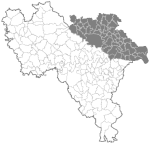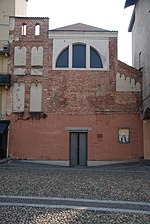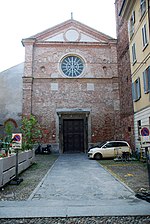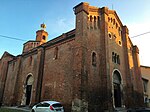Pavia Cathedral
17th-century Roman Catholic church buildings in ItalyCathedrals in LombardyRenaissance architecture in LombardyRoman Catholic cathedrals in ItalyRoman Catholic churches in Pavia

Pavia Cathedral (Italian: Duomo di Pavia) is a church in Pavia, Italy, the largest in the city and seat of the Diocese of Pavia. The construction was begun in the 15th century on the site of two pre-existing Romanesque, "twin" cathedrals (Santo Stefano and Santa Maria del Popolo). The cathedral houses the remains of St. Sirus, first Bishop of Pavia, and a thorn purported to be from the Crown of Thorns worn by Christ. The marble facing of the exterior was never completed. The Civic Tower (Torre Civica), known in 1330 and enlarged in 1583, formerly stood next to the cathedral. It collapsed on March 17, 1989.
Excerpt from the Wikipedia article Pavia Cathedral (License: CC BY-SA 3.0, Authors, Images).Pavia Cathedral
Piazza Cavagneria, Pavia Borgo Ticino
Geographical coordinates (GPS) Address Nearby Places Show on map
Geographical coordinates (GPS)
| Latitude | Longitude |
|---|---|
| N 45.184583333333 ° | E 9.1536111111111 ° |
Address
Cattedrale di Santo Stefano e Santa Maria Assunta (Duomo di Pavia)
Piazza Cavagneria
27100 Pavia, Borgo Ticino
Lombardy, Italy
Open on Google Maps










